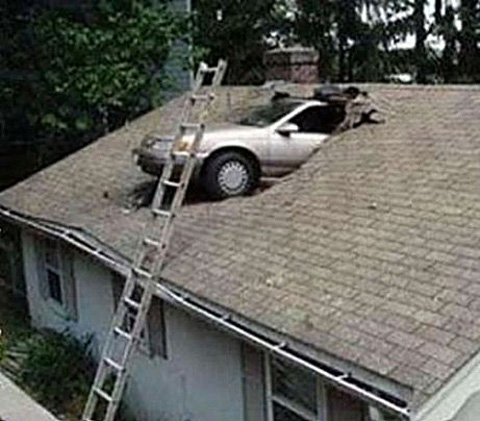Q: Just bought my first car, at a price I’m happy with. I shopped around, took advantage of 0% financing, even remembered to walk away when the first dealer hardballed me. Christ, now I have to buy insurance?
A: Yes, even if you look both ways at every intersection and keep your hands perpetually at 10 and 2. If you’re going to operate a lethal piece of machinery, your state requires you to get covered. Considering you might cause hundreds of thousands in damages, better to pay $100 or $200 a month and let the insurer cut any six-digit check. Drive uninsured and you’re looking at fines of up to $1700, which isn’t exactly building wealth.
Q: I see Progressive commercials every day, they must be good. I’ll buy from them.
A: Don’t marry the first person you date. Compare rates at a clearinghouse like NetQuote. Don’t go to Insure.com, which looks like a clearinghouse but is owned by GEICO. Not that GEICO’s bad, but shop around.
Look, one insurer’s policy is basically identical to the next. The big differences are in the coverage limits and deductibles.
Q: Excuse me, “coverage limits”? “Deductibles”?
A: Oh, right. You’re a product of the American educational system and never learned this.
Your policy covers different types of scenarios (e.g. you injure someone, you wreck someone’s car) and part of your monthly bill goes to each.
About one-third of your policy is for bodily injury coverage, expressed as a pair of figures (e.g. $100,000/$300,000.) Which means if you injure someone, your policy pays up to $100,000 per injured person, $300,000 per accident. If you get sued, your legal fees are also covered up to the latter number. Coverage limits on this can range from $15,000/$30,000 to $300,000/$500,000. Obviously the greater your coverage, the more you pay. $100,000/$300,000 is a happy medium between underexposure and overkill.
Q: I asked you what a deductible is. Should I just go to someone else’s blog?
A: If you’re in a crash, it’s the designated amount you have to pay out before your insurance kicks in.
About another third of your policy goes toward collision insurance. Say you carry a $500 deductible here, and you cause $6000 in damage. The insurer pays $5500, you pay the rest. You choose your deductible – 0, $100, $250, $500, $1000. The higher it is, the cheaper your premia.
Q: So should I save money and assume I won’t get in an accident, or pay more so I can breathe more easily?
A: Say you pull out of a parking space and hit someone’s bumper, causing $377 worth of dents and scratches. If you have no deductible you pay nothing, but your rates will rise. In the same situation with a $500 deductible, you’ll pay the whole shot. You’re also probably not going to tell your insurer.
With a $0 deductible your rates will rise to the point where you’ll be out $377 anyway, the only difference being that it’ll take maybe a year instead of a day. Assuming you’re not the kind of person who balances a cell phone and a burrito on her lap while cruising in the left lane, get a $500 deductible. A $1000 deductible is too big a hit to pay if your car causes, say, $940 in damage, and a $250 deductible means you’ll be paying rates that are maybe 10% higher than if you carry a $500 deductible.
Q: If every other driver on the road is insured, I’m fine, right?
A: Millions of jackballs drive without enough (or any) insurance: estimates range as high as 25% of drivers in some states. There’s also a little thing called hit-and-run, too.
Given those odds, pay the extra $25 or so a year and get covered against bodily injury from un(der)insured drivers. $15,000/$30,000 is enough to cover your passengers, too. If you live in Illinois, Maryland or New York, this coverage is required anyway.
Q: Say I do hit someone. Does it make a difference if I hit an Escort rather than a Lexus?
A: Damn straight it does. After bodily injury and collision coverage, about half of the rest of your policy covers property damage. Plus legal defense if you need it. Get $50,000 worth, which should cover the price of most any car you decide to crash into.
Q: Anything else?
A: Cars don’t get damaged only in crashes. Your car could get stolen, hit by lightning, hit by a deer, or torched in a Los Angeles Lakers postgame riot. Get comprehensive coverage for this, with a $500 deductible. Comprehensive coverage costs around $100 a year. Some policies cover medical payments, too.
Q: Which I don’t need if I have health insurance, right?
A: No, you do. Not for yourself so much as for any other people in an accident. When lawyers chase ambulances, medical payments coverage is the first thing they go after. Again, this works out to a few dollars a month. Totally worth it.
Q: This is starting to sound pricey. Where can I save?
A: There are vast swaths of the average policy that a smart driver can live without. Don’t get uninsured property damage coverage, which covers damage an uninsured driver does to property other than your car. You only need this if you live on a traffic island or drive around with Ming vases strapped to your roof.
Q: So someone hits me and I’m covered under their policy. Then what? I still need my car, and it’s going to take a while to fix.
A: Check the box for rental reimbursement when you buy your policy. It costs twenty-something bucks a year – less than a day’s rental – and gets you a loaner for up to a month.
If you’re shopping for a new vehicle, first calculate how much insurance will cost. If you can’t decide between an Accord and a Hummer H2, don’t flip a coin. If insurance quotes on the one are double those of the other, get the Accord.
Q: Too late, I already bought. With 0% financing. Didn’t you see my first question?
A: Okay then, smart guy: that means you owe money, probably more than your car’s street value. What if your car gets totaled?
Q: Uh…I figured the lender eats it.
A: Then you’re an idiot. But if you had loan/lease coverage, you wouldn’t be.
If you owe $16,000 on a car that the insurer values at $14,000, loan/lease (“gap”) insurance makes up the difference. For like $3 a month. You can only go without this coverage if you drive something held together with baling wire and duct tape (or if you own the car outright, of course.)




